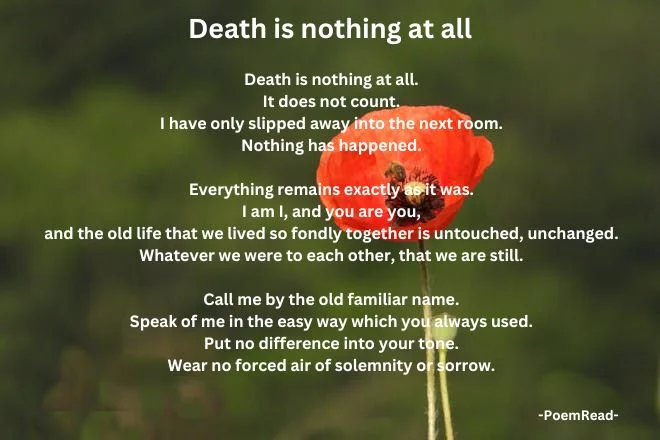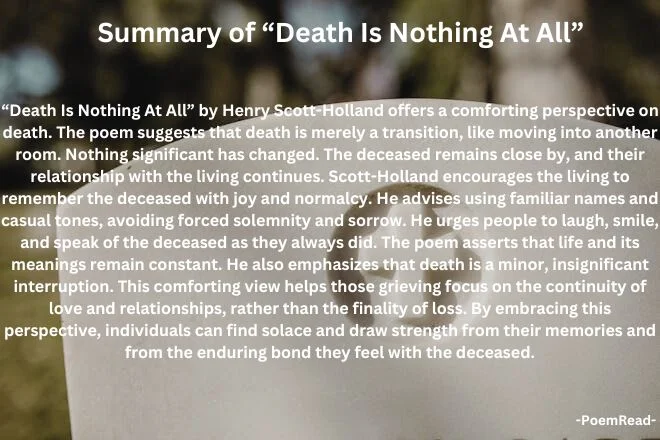
‘Death is Nothing at All’ by Henry Scott-Holland is a comforting poem that addresses the subject of death from a unique perspective. The poem brings solace to those grieving, emphasizing the continuity of love and life beyond death. In this article, we’ll explore the various aspects of this literary work, from the author’s background to the poem’s theme, tone, and structure.
Death is nothing at all
Death is nothing at all.
It does not count.
I have only slipped away into the next room.
Nothing has happened.
Everything remains exactly as it was.
I am I, and you are you,
and the old life that we lived so fondly together is untouched, unchanged.
Whatever we were to each other, that we are still.
Call me by the old familiar name.
Speak of me in the easy way which you always used.
Put no difference into your tone.
Wear no forced air of solemnity or sorrow.
Laugh as we always laughed at the little jokes that we enjoyed together.
Play, smile, think of me, pray for me.
Let my name be ever the household word that it always was.
Let it be spoken without an effort, without the ghost of a shadow upon it.
Life means all that it ever meant.
It is the same as it ever was.
There is absolute and unbroken continuity.
What is this death but a negligible accident?
Why should I be out of mind because I am out of sight?
I am but waiting for you, for an interval,
somewhere very near,
just round the corner.
All is well.
Nothing is hurt; nothing is lost.
One brief moment and all will be as it was before.
How we shall laugh at the trouble of parting when we meet again!
Content
- About the Author: Henry Scott-Holland
- Subject of “Death Is Nothing At All”
- Context of “Death Is Nothing At All”
- Theme and Tone of “Death Is Nothing At All”
- Persona, Setting, and Narrative
- Structure and Form of “Death Is Nothing At All”
- Stanza-by-Stanza Analysis of “Death Is Nothing At All”
- Poetic and Literary Devices Used in “Death Is Nothing At All”
- Implications and Meanings of “Death Is Nothing At All”
- Interactive Summary
About the Author: Henry Scott-Holland
Henry Scott-Holland (1847–1918) was a prominent English clergyman and theologian, best known for his compassionate and relatable sermons. Educated at Balliol College, Oxford, he went on to become a canon at St. Paul’s Cathedral in London. Scott-Holland’s works often reflect his deep empathy and his desire to bridge the gap between spiritual and everyday life. His poem “Death Is Nothing At All” remains one of his most enduring legacies, capturing his gentle yet profound approach to the subject of death.
Subject of “Death Is Nothing At All”
“Death Is Nothing At All” addresses the subject of death and its impact on the living. Henry Scott-Holland presents death not as an end but as a simple transition, akin to moving into another room. He urges the living to continue their lives as they did when the deceased was present. The poem emphasizes that relationships and love remain unchanged by death. Scott-Holland reassures that the bond between the living and the deceased endures undiminished.
This comforting perspective helps mitigate the fear and sorrow that often accompany death. By encouraging people to remember the deceased with joy and normalcy, the poem offers a path to cope with loss. The message is clear: death should not overshadow the vibrant memories and love shared. This approach makes the poem a source of solace and hope for those grieving.
Context of “Death Is Nothing At All”
Henry Scott-Holland composed “Death Is Nothing At All” as a part of his sermon “Death the King of Terrors,” which he delivered in 1910 following the passing of King Edward VII. The sermon was intended to provide comfort and solace to those mourning the king’s passing, and the poem itself reflects this purpose.
The context of the poem is deeply rooted in Christian theology and the belief in an afterlife. Scott-Holland, an English clergyman and theologian, sought to offer a perspective on death that aligned with Christian teachings about eternal life and the continuity of the soul. The poem’s message is one of reassurance, suggesting that death is not an end but a transition to another state of being.
During the early 20th century, when the poem was written, death was a common and often public experience due to the high mortality rates and the impact of wars and diseases. The poem’s comforting and hopeful tone would have resonated with many people facing loss and grief, providing them with a sense of peace and continuity.
Theme and Tone of “Death Is Nothing At All”
Theme
The central theme of “Death Is Nothing At All” by Henry Scott-Holland is the continuity of life and the enduring nature of love. The poem challenges the conventional perception of death as a final, sorrowful event. Instead, it presents death as a minor transition, emphasizing that the bonds of love and memory remain unbroken. The speaker reassures the living that their relationship with the deceased continues unchanged, urging them to maintain their usual routines and attitudes.
Another significant theme is the idea of eternal life, rooted in Christian theology. The poem reflects the belief that death is not an end but a passage to another state of existence. This perspective provides comfort and hope, suggesting that the separation caused by death is temporary and that a joyful reunion awaits in the afterlife.
Tone
The tone of the poem is calm, comforting, and reassuring. Scott-Holland uses a conversational and intimate style, addressing the reader directly to create a sense of closeness and familiarity. The speaker’s gentle and soothing language aims to alleviate the fear and sorrow associated with death, offering a perspective that is both hopeful and uplifting.
The poem’s tone is also reflective and contemplative, encouraging the reader to think deeply about the nature of life and death. By downplaying the significance of death and emphasizing the continuity of life, the speaker fosters a sense of peace and acceptance. The overall effect is one of solace, providing comfort to those grieving the loss of a loved one.
Persona, Setting, and Narrative
Persona
In “Death Is Nothing At All,” the persona is the voice of someone who has passed away, addressing the living. This speaker adopts a calm, reassuring, and intimate tone, aiming to comfort those who are grieving.
The persona’s voice is gentle and familiar, using everyday language to convey a sense of continuity and unbroken connection. By speaking directly to the reader, the persona creates a personal and heartfelt dialogue, emphasizing that death has not changed the essence of their relationship.
Setting
The setting of the poem is abstract and metaphysical, as it deals with the concepts of death and the afterlife. There are no specific physical locations mentioned; instead, the poem creates a sense of a shared, familiar space that transcends the boundaries of life and death.
The metaphor of “slipping away into the next room” suggests a setting that is close and accessible, reinforcing the idea that the speaker is still nearby, just out of sight. This setting helps to convey the poem’s message that death is not a distant or final separation but a continuation of the same existence.
Narrative
The narrative of “Death Is Nothing At All” is straightforward and reflective. The speaker addresses the reader directly, offering a series of reassurances about the nature of death and the continuity of life. The narrative unfolds as a conversation, with the speaker providing comforting thoughts and reflections to ease the reader’s grief. The poem’s structure, with its varying stanza lengths and natural pauses, mirrors the flow of a heartfelt dialogue.
The narrative begins with the speaker asserting that death is insignificant and that nothing has changed. The speaker then elaborates on this idea, emphasizing the continuity of life and the unbroken bonds of love and memory. Throughout the poem, the speaker encourages the reader to maintain their usual routines and attitudes, to speak of the deceased in the same familiar way, and to find joy in shared memories. The narrative concludes on a hopeful note, suggesting that the separation is temporary and that a joyful reunion awaits.
Structure and Form of “Death Is Nothing At All”

“Death Is Nothing At All” by Henry Scott-Holland is a free verse poem, meaning it does not adhere to a specific rhyme scheme or meter. This choice of form allows the poem to flow naturally, mirroring the conversational and intimate tone of the speaker. Let’s break down the form and structure in more detail:
Stanzas and Length
The poem is composed of seven stanzas of varying lengths. This irregular structure contributes to the poem’s informal and personal feel, as if the speaker is having a direct conversation with the reader. The varying stanza lengths also help to emphasize different parts of the message, allowing the speaker to pause and reflect at key moments.
Pauses and Line Breaks
Scott-Holland uses pauses and line breaks effectively to create a natural rhythm and to emphasize certain ideas. For example, the line “I have only slipped away into the next room” is followed by a pause, allowing the reader to absorb the comforting metaphor before moving on. These pauses and breaks help to convey the speaker’s calm and reassuring tone, making the poem feel more like a gentle conversation.
Punctuation
The poem features minimal punctuation, which adds to its conversational flow. The lack of heavy punctuation allows the lines to run smoothly into one another, reinforcing the idea of continuity and unbroken connection. This stylistic choice also helps to maintain the poem’s soothing and reassuring tone.
Rhyme and Rhythm
There is no consistent rhyme scheme in the poem, which aligns with its free verse form. The absence of rhyme allows the poem to maintain a natural and unforced quality, making the speaker’s message feel more genuine and heartfelt. The rhythm is also irregular, further contributing to the poem’s conversational style.
Meter
While the poem does not follow a strict metrical pattern, it employs a natural cadence that mimics everyday speech. The lines vary in length and stress patterns, creating a rhythm that feels spontaneous and sincere. This lack of a fixed meter enhances the poem’s intimate and personal tone, making it seem as though the speaker is directly addressing the reader in a heartfelt conversation.
Significance of Form and Structure
The free verse form and irregular structure of “Death Is Nothing At All” are significant because they reflect the poem’s themes of continuity and unbroken connection. The lack of formal constraints allows the speaker’s voice to come through clearly and naturally, creating a sense of intimacy and immediacy. This structure also mirrors the poem’s message that life and relationships continue seamlessly despite physical absence.
Stanza-by-Stanza Analysis of “Death Is Nothing At All”
First Stanza
Death is nothing at all.
It does not count.
I have only slipped away into the next room.
Nothing has happened.
In the first stanza, Scott-Holland immediately minimizes the importance of death. He asserts that death doesn’t really matter, implying it’s insignificant. By describing it as “slipped away into the next room,” he uses a simple, relatable metaphor. This suggests that the deceased person is still nearby, just not visible. Saying “nothing has happened” reinforces the idea that death hasn’t caused any real change. This comforting perspective aims to ease the fear and sorrow associated with death.
Second Stanza
Everything remains exactly as it was.
I am I, and you are you,
and the old life that we lived so fondly together is untouched, unchanged.
Whatever we were to each other, that we are still.
In this stanza, Scott-Holland emphasizes that life and relationships remain unchanged by death. He repeats “I am I, and you are you” to highlight the continuity of identities. The phrase “the old life that we lived so fondly together” evokes cherished memories, suggesting that these remain intact. By stating, “whatever we were to each other, that we are still,” he reassures that the bond shared with the deceased continues. This idea provides comfort by affirming that death doesn’t alter the essence of relationships.
Third Stanza
Call me by the old familiar name.
Speak of me in the easy way which you always used.
Put no difference into your tone.
Wear no forced air of solemnity or sorrow.
Scott-Holland encourages the living to remember and speak of the deceased naturally. He advises using the same “old familiar name,” promoting a sense of normalcy. By saying “speak of me in the easy way,” he suggests maintaining the same casual and affectionate manner as before. The instructions to “put no difference into your tone” and avoid a “forced air of solemnity or sorrow” stress the importance of keeping interactions and memories light-hearted. This approach helps keep the deceased’s memory alive in a comforting and familiar way.
Fourth Stanza
Laugh as we always laughed at the little jokes that we enjoyed together.
Play, smile, think of me, pray for me.
Let my name be ever the household word that it always was.
Let it be spoken without an effort, without the ghost of a shadow upon it.
In this stanza, Scott-Holland encourages joyful remembrance. He urges the living to laugh at the same jokes and continue to “play, smile, think of me, pray for me.” This reinforces the idea of maintaining a positive and active memory of the deceased. By stating, “let my name be ever the household word,” he suggests that the deceased’s name should remain part of everyday conversation. The phrase “without the ghost of a shadow upon it” implies that the name should be spoken without any sadness. This encourages a light and natural remembrance.
Fifth Stanza
Life means all that it ever meant.
It is the same as it ever was.
There is absolute and unbroken continuity.
What is this death but a negligible accident?
Scott-Holland reaffirms that the essence of life remains unchanged by death. He asserts that “life means all that it ever meant” to emphasize continuity. By stating “it is the same as it ever was,” he reassures that life’s core remains intact. The phrase “absolute and unbroken continuity” reinforces the idea that death is merely a small interruption. By calling death a “negligible accident,” he minimizes its impact. This perspective helps reduce the fear and sorrow associated with death.
Sixth Stanza
Why should I be out of mind because I am out of sight?
I am but waiting for you, for an interval,
somewhere very near, just round the corner.
Scott-Holland challenges the notion that the deceased should be forgotten simply because they are not visible. He asks, “why should I be out of mind because I am out of sight?” to emphasize that the deceased is still present in thought. By describing the deceased as “waiting for you, for an interval,” he suggests a temporary separation. The imagery of being “somewhere very near, just round the corner” implies closeness and accessibility. This offers comfort by suggesting that the deceased is still nearby and will be seen again.
Seventh Stanza
All is well.
Nothing is hurt; nothing is lost.
One brief moment and all will be as it was before.
How we shall laugh at the trouble of parting when we meet again!
In the final stanza, Scott-Holland provides a powerful reassurance. He begins with “all is well” to affirm that everything is fine. By stating “nothing is hurt; nothing is lost,” he emphasizes that death has not caused any real damage or loss. He suggests that the separation is brief, saying “one brief moment and all will be as it was before.” The anticipation of reunion, with the phrase “how we shall laugh at the trouble of parting when we meet again,” provides hope and comfort. Ultimately, this ending reinforces the poem’s message of continuity and the transient nature of death.
Poetic and Literary Devices Used in “Death Is Nothing At All”

Metaphor
Scott-Holland uses metaphors to convey his message about death. He compares death to slipping away into another room. This metaphor suggests that the deceased is still close by, just out of sight. It helps readers visualize death as a minor transition rather than a final end. This simple comparison makes the concept of death less intimidating and more relatable.
Repetition
Repetition is another key device in the poem. Scott-Holland repeats phrases like “I am I, and you are you” to emphasize the continuity of identity and relationships. This repetition reinforces the idea that nothing essential changes after death. It helps to comfort the reader by highlighting the unbroken nature of life and love despite physical separation.
Tone
The tone of the poem is gentle and reassuring. Scott-Holland uses a calm and comforting voice throughout the poem. This tone helps to alleviate the fear and sorrow often associated with death. By maintaining a consistent, soothing tone, he provides solace and peace to the reader. The tone ensures that the poem’s message is received in a comforting manner.
Imagery
Scott-Holland employs vivid imagery to create a sense of closeness and continuity. Phrases like “just round the corner” and “slipped away into the next room” create visual images that make the concept of death more accessible. This imagery helps the reader to see death as a natural part of life. It brings a sense of nearness and familiarity to the idea of death, reducing its fearfulness.
Free Verse
The poem is written in free verse, without a strict rhyme scheme or meter. This structure mirrors the natural flow of conversation. It makes the poem feel more personal and intimate. Free verse allows Scott-Holland to express his thoughts fluidly. This enhances the poem’s comforting and relatable nature.
Direct Address
Scott-Holland uses direct address to speak directly to the reader. He uses phrases like “call me by the old familiar name” and “speak of me in the easy way.” This direct approach makes the poem feel like a personal message from the deceased to their loved ones. It creates an intimate connection with the reader, making the poem’s message more impactful.
Additional Literary and Poetic Devices Used in “Death Is Nothing At All”
Anaphora
Scott-Holland employs anaphora, the repetition of a word or phrase at the beginning of successive clauses, to reinforce key ideas. For instance, the repetition of “Let” in the fourth stanza (“Let my name be ever the household word that it always was. Let it be spoken without an effort…”) emphasizes the continuity of the deceased’s presence in daily life. This technique strengthens the message and makes the poem more memorable.
Alliteration
Alliteration, the repetition of consonant sounds at the beginning of words, can be found in the poem. For example, “slipped away into the next room” uses the soft ‘s’ sound to create a soothing and gentle tone. This device subtly enhances the poem’s comforting atmosphere.
Parallelism
Scott-Holland uses parallelism to create a rhythm and enhance the poem’s readability. Parallel structures like “Play, smile, think of me, pray for me” create a balanced and rhythmic flow. This technique helps to emphasize the actions the speaker wants the reader to continue, reinforcing the poem’s message of maintaining normalcy.
Antithesis
Antithesis, the juxtaposition of contrasting ideas, is used to highlight the difference between life and death. For example, the poem contrasts the idea that “nothing has happened” with the usual perception of death as a significant, disruptive event. This juxtaposition challenges traditional views of death and supports the poem’s theme of continuity.
Euphemism
Scott-Holland uses euphemism to soften the harsh reality of death. Describing death as “slipped away” and being “just round the corner” makes the concept less frightening. These gentle expressions help to mitigate the fear and sorrow associated with death, aligning with the poem’s comforting tone.
Personification
In a subtle way, Scott-Holland personifies death by suggesting it has the ability to cause disruption, which he then denies (“Death is nothing at all”). By addressing death as if it were a person that could impact life, he emphasizes its insignificance when it comes to relationships and love.
Hyperbole
Scott-Holland uses hyperbole to minimize the impact of death, referring to it as a “negligible accident.” This exaggeration serves to downplay the significance of death, reinforcing the idea that it should not be seen as a catastrophic event but rather a minor inconvenience.
Conversational Language
The use of conversational language makes the poem more accessible and relatable. Phrases like “call me by the old familiar name” and “speak of me in the easy way” mimic everyday speech. This device helps to create an intimate, personal connection between the speaker and the reader, making the poem’s message more comforting.
Implications and Meanings of “Death Is Nothing At All”
“Death Is Nothing At All” by Henry Scott-Holland carries deep implications and meanings about how we perceive death and cope with loss. The poem suggests that death should not be seen as an end, but rather as a mere transition. Scott-Holland’s message implies that the bonds we share with our loved ones remain intact even after they pass away. This perspective can significantly influence how individuals deal with grief, encouraging them to focus on the continuity of their relationships instead of the finality of death.
The poem also challenges traditional views of mourning. By advising against solemnity and encouraging normalcy, Scott-Holland implies that we should celebrate life and cherish memories without succumbing to prolonged sorrow. This approach can help people find comfort and maintain emotional well-being during difficult times.
Furthermore, the poem underscores the idea of proximity between the living and the deceased. Scott-Holland describes the deceased as being “just round the corner,” suggesting that they are still near and accessible. This notion can provide solace to those grieving, offering a sense of closeness and ongoing connection.
Ultimately, the poem’s meanings revolve around the themes of love, continuity, and resilience. It encourages the living to honor their relationships with the deceased by maintaining a positive and enduring remembrance. This perspective can foster a healthier approach to dealing with loss, transforming the way people experience and process grief.
Interactive Summary

“Death Is Nothing At All” by Henry Scott-Holland offers a comforting perspective on death. The poem suggests that death is merely a transition, like moving into another room. The deceased remains close by and still connected to the living. Scott-Holland emphasizes that relationships and love do not change with death. He encourages the living to continue speaking of the deceased in a familiar, joyful way.
Why should we let death change our memories and actions? The poet asks us to maintain normalcy and remember the good times. He advises against forced solemnity and sorrow, urging us to keep the deceased’s name alive in everyday conversation. By viewing death as a negligible event, we can focus on the unbroken continuity of life. This approach helps us cope with loss by cherishing the ongoing presence of our loved ones in our hearts and minds.
If you found “Death Is Nothing At All” intriguing, explore our analysis of “Do Not Go Gentle into That Good Night” by Dylan Thomas. It offers a contrasting view on mortality, urging defiance and contemplation in response to the inevitability of death.
RELATED POSTS
View all



